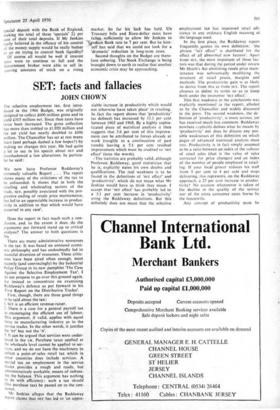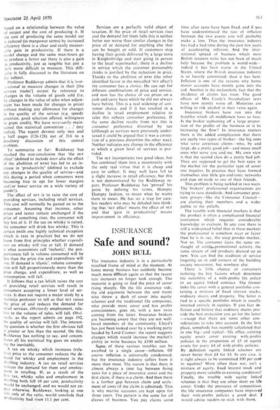SET: facts and fallacies
JOHN CHOWN
The selective employment tax, first intro- duced in the 1966 Budget, was originally designed to collect £600 million gross and to yield £315 million net. Since then rates have twice been increased. The gross collection has more than trebled to £1,920 million and the net yield has nearly doubled to £606 million. The Chancellor has set at rest many fears (and perhaps dashed a few hopes?) by making no changes this year. He had quite a lot to say in his speech about SET and foreshadowed a few alterations. In particu- lar he said: We now have Professor Reddaway's extremely valuable Report . . . The report shows many of the criticisms of the tax to he unfounded. It shows that in both the retailing and wholesaling sectors of the trade, SET, possibly associated with the pro- gressive ending of resale price maintenance, has led to an appreciable increase in produc- tivity in addition to that which would have occurred in any case'.
Does the report in fact reach such a con- clusion, and, to the extent it does. do the arguments put forward stand up to critical analysis? The answer to both questions is No.
There are many administrative nonsenses in the tax. It was based on unsound econo- mic philosophy and has undoubtedly led to wasteful diversion of resources. These critic- isms have been aired often enough, most recently (and convincingly) by the Industrial Policy Group in its new pamphlet 'The Case Against the Selective Employment Tax'. I do not propose to go over this ground again, but instead to concentrate on examining Reddaway's defence as put forward in his 'First Report on the Distributive Trades'.
First, though, there are three good things to be said about the tax: I. SET is an efficient revenue-raiser.
2. There is a case for a general payroll tax as encouraging the efficient use of labour. This argument, if valid, applies with equal force to manufacturing industry as to the service trades. In the other words, it justifies the 'Er' but not the 's'.
3. It can be argued that services were under- taxed in the tmc. Purchase taxes applied at the wholesale level cannot be applied to ser- vices, and we do not have the machinery to collect a point-of-sales retail tax which in other countries does include services. A special tax on employment in the service. trades provides a rough and ready, but administratively workable. means of redress- ing the balance. This argument has nothing to do with efficiency: such a tax should (like purchase tax) be passed on to the con- sumer.
Mr Jenkins alleges that the Reddaway report claims that SET has led to 'an appre-
ciable increase in productivity which would not otherwise have taken place' in retailing. In fact the report shows that 'productivity' (as defined) has increased by 11.1 per cent between 1965 and 1968. By a highly sophis- ticated piece of statistical analysis it then suggests that 5.6 per cent of this improve- ment can be attributed to forces already at work (roughly to a continuation of past trends) leaving a 5.1 per cent residual improvement which must be credited to 'SET effect' (note the words).
The statistics are probably valid, although Professor Reddaway, good statistician that he is, explicitly states his own doubts and qualifications. The real weakness is to be found in the definitions of 'SET effect' and 'productivity', which do not mean what Mr Jenkins would have us think they mean. I accept that 'SET effect' has probably led to a 5.1 per cent increase in 'productivity' using the Reddaway definitions. But this definitely does not mean that the selective employment tax has improved retail effi- ciency in any ordinary English meaning of the language used.
In the first place, the Reddaway report frequently quotes its own definition: 'the phrase "SET effect" is shorthand for the effect of all abnormal new factors'. Apart from SET, the most important of these fac- tors was that during the period under review Mr Heath's Act abolishing resale price main- tenance was substantially modifying the structure of retail prices, margins and methods. The productivity gain is as likely to derive from this as from SET. The report chooses to define its terms so as to lump both under the misnomer 'SET effect'.
This first weakness in the conclusions was explicitly mentioned in the report, alluded to by the Chancellor and widely discussed in the press. The second weakness, the de- finition of 'productivity', is more serious, yet has received much less comment. Reddaway nowhere explicitly defines what he means by 'productivity' nor does he discuss any pos- sible weaknesses of this definition on which pages of advanced statistical analysis must rest. Productivity is in fact simply assumed to be a ratio between an index of the volume of retail sales (that is the value of sales corrected for .price changes) and an index of the number of people employed in retail- ing. If your local grocer reduces his staff from 5 per cent to 4 per cent and stops delivering, this represents, on the Reddaway approach, a 25 per cent increase in produc- tivity! No account whatsoever is taken of the decline in the quality of the service nor of the extra consumer costs borne by the housewife.
Any concept of productivity must be
based on a relationship between the value of output and the cost of producing it. If the cost of producing the same model car is reduced (in manpower terms) by increased efficiency there is a clear and easily measur- able gain in productivity. If there is a model change and the same man-hours go to produce a better car there is also a gain in productivity, just as tangible but just a little more difficult to measure. This diffi- culty is fully discussed in the literature on the subject.
Professor Reddaway admits that it is `con= ventional to measure changes in their [the services trades'] output by reference to changes in the volume of goods sold (i.e. by changes in the value of sales when adjust- ment has been made for changes in price) without making any allowance for changes in the quality of the service (e.g. speedy attention, good selection offered, willingness to grant credit). We have necessarily main- tained this statistical convention . . (my italics). The report devotes only two and a half -pages (126-128) out of 316 to a desultory discussion of this central. problem.
To summarise so far: Reddaway has reached the non-conclusion that 'the SET effect' (defined to include inter alia the effect of the abolition of RPM) has led to an in- crease in 'productivity' (defined to exclude any changes in the quality of service—and this during a period when consumers were becoming free to opt for lower margins and/or lower service on a wide variety of goods!).
The effect of SET is to raise the cost of providing services, including retail services. This cost will normally be passed on to the consumer. Assuming that incomes, other prices and tastes remain unchanged if the price of something rises, the consumer will buy less of it. If the tax on whisky is raised, the consumer will drink less whisky. This is certain (with one highly technical exception which is rare in practice) but we do not know from first principles whether expendi- ture on whisky will rise or fall. If demand is what economists call 'inelastic', the pro- portionate fall in volume consumed will be less than the price rise and expenditure will rise. If demand is 'elastic', volume consump- tion will fall proportionately more than the price change, and expenditure, as well as consumption, will fall. It follows that a tax 'Which raises the cost of providing retail services will result in consumers accepting a lower level of ser- vices. It does not require a major study by a statistics professor to tell us that SET raises the price of and reduces the demand for retail services. Obviously employment, rela- tive to the volume of sales, will fall. Obvi- ously, as the report admits on page 192, the quality of service will fall. The interest- ing question is whether the first obvious fall is greater or less than the second. On this, Reddaway has nothing to say. and concen- trates all his statistical big guns on analys- ing the inevitable.
A tax on whisky which increases (rela• tive) price to the consumer reduces the de- mand for whisky and employment in the distilling industry. A tax on retail services reduces the demand for them and emoloy- ment in retailing. If, as a result of the first tax, whisky sales and employment in distilling both fell 10 per cent, productivity would be unchanged, and we would not ex- pect otherwise. Reddaway, looking at one side only of the ratio, would conclude that productivity had risen 11.1 per cent. Services are a perfectly valid object of taxation. If the price of retail services rises and the demand for them falls this is neither better nor worse than similar changes in the price of or demand for anything else that can be bought or sold. If customers stop having their goods delivered by a large store in Knightsbridge and start going in person to the local supermarket, there is a decline in service which the customer presumably thinks is justified by the reduction in price. Thanks to the abolition of RPM (the other identified factor in the miscalled 'SET effect') the consumer has a choice. He can opt for different combinations of price and service, and now has the choice of cut prices on a cash and carry basis which he did not always have before. This is a real widening of con- sumer choice, and if it has resulted in a decline in retail employment relative to sales this reflects consumer preference. If the same decline results from SET this is consumer preference distorted by tax (although as services were previously under- taxed it could be argued that it was a correc- tion of a previous distortion the other way). Neither indicates any change in the efficiency at which a given level of services is pro- vided.
The SET incorporates two good ideas, but has combined them into a monstrosity with the only real virtue that it is cheap and easy to collect. It may well have led to a slight increase in retail efficiency, but this is not demonstrated by the Reddaway re- port. Professor Reddaway has 'proved' his point by defining his terms, Humpty Dumpty fashion, to mean what he wants them to mean. He has set a trap for care- less readers who may be deluded into think- ing that 'SET effect' -means the effect of SET and that 'gain in productivity' means improvement in efficiency.







































 Previous page
Previous page